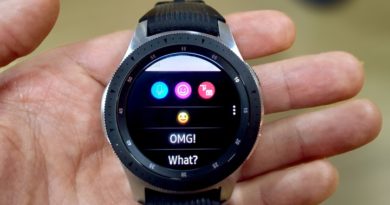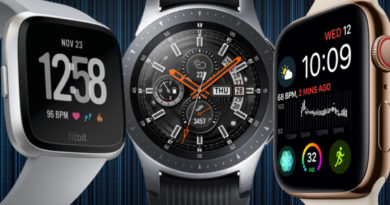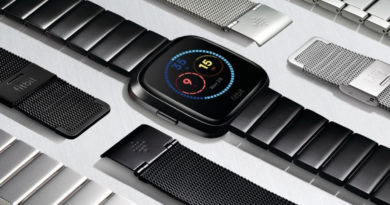ECG wearables: How they work and the best on the market
Heart rate monitors are part and parcel of smartwatches and fitness trackers now, but electrocardiogram (ECG) is the new key sensor in town.
The technology is designed to help people keep tabs on their heart health, and can identify atrial fibrillation (Afib) which is a serious medical condition, and a leading cause of stroke.
Apple threw ECG into the spotlight with the launch of the Apple Watch Series 4 and it’s starting to find its way into other smartwatches – including the new Withings ScanWatch. But what is it, and why do we need it?
Wareable verdict: How to use the Apple Watch ECG featureWhat is ECG?Most of the wearables on the market at the moment have optical heart rate monitors inside them. This is a monitor that uses flashing LEDs to penetrate the skin and detect blood flow. When light is reflected off the flow of blood, it’s captured by the sensors. The algorithm then gets to work to produce heart rate data.
But it’s not as accurate as it could be – especially where medical issues are involved.
Enter the electrocardiogram (ECG or EKG). Rather than measuring blood flow, it’s designed to measure how well your heart is working.
It’s a term you’d more commonly hear in the medical industry, referring to an electrocardiograph that’s used to detect any cardiac abnormalities.
How does ECG technology work?An ECG records the tiny electrical signals that are generated by the beating of your heart under your skin, which it presents as a trace. This then allows trained professionals, machines or wearables to understand more about how your heart is functioning – and determine if there are any abnormalities.
“In the simplest sense, it can tell you the heart rate (how fast), the rhythm (how regular), the state of the conduction system and muscle tissue (heart attacks), and even the level of certain chemicals like potassium in the blood, and the effect of medication,” says Dr Keith Grimes, GP and Clinical Innovation Director at Babylon Health.
An electrocardiograph in a medical setting usually requires placing electrodes on the skin situated close to the heart, which measure electrical activity produced by the heart as it contracts. The electrical activity is sent to a receiver that records the information, and this is where the heart’s rhythm can be analysed and irregularities can be detected.
But the tech inside the Apple Watch (and other ECG-reading devices you can use at home) works differently.
For example, rather than place electrodes on your skin, the Apple Watch requires you to hold your finger on the device’s digital crown. Wait for 30 seconds and the electrical activity of your heart draws a red trace across the watch’s screen. Once you’re done, the app will let you know whether the trace captured a normal heartbeat, called a sinus rhythm, or an abnormal heart beat.
The biggest difference between an electrocardiograph at a hospital and the ECG tech in your Apple Watch is the first is a 12 lead and the latter is a single lead. In the simplest terms, the 12 lead is taking lots of readings about your heart – the single lead is taking one.
That means a single lead ECG has limited capabilities and offers a single view of your heart. It can’t be relied upon to detect all heart rhythm abnormalities – or worsening heart problems. It also can’t be relied upon to detect the electrical changes that take place during a heart attack or abnormal heart structure.
Both Apple and AliveCor make this clear, but it’s important to differentiate between what an ECG at the hospital can offer and what tech you use at home can offer.
How can ECG tech save your life?An ECG carried out by a medical professional can identify many issues with your heart. But ECG devices designed to be used at home aren’t quite there yet.
Here are a few of the ways the ECG tech found in your Apple Watch or KardiaBand can currently save your life, including the problems that they can identify and the others they might be able to.
Atrial fibrillationAtrial fibrillation is a heart condition that can cause an irregular and abnormally fast heartbeat. It’s common and potentially deadly. This is the one condition that both Apple and AliveCor are FDA-cleared to detect.
ZDNet writer Jason Perlow was part of the early testing of Apple’s Atrial fibrillation detection, and identified a problem with his heart in 2018 thanks to the data that was collected.
The reason personal devices are effective at recognising this particular kind of arrhythmia (irregular heartbeat), and the reason Perlow cites for its effectiveness in his case, is because you can take them at any time.
Unlike getting an ECG at the hospital, you can monitor your heart throughout the day. “Irregularities in heart rate can be episodic, and difficult to capture,” explains Dr Grimes, “So a personal ECG that you carry with you can help clinicians record when palpitations happen and help with diagnosis.”
This means you can take a 30-second ECG whenever you feel symptoms and also better understand the context of what may have brought them on. For example, if you just got back from a run and you’re feeling a bit off.
Dr. Julia Reynolds, Associate Director at Innovation Agency, tells us that the Kardia Mobile is sometimes even prescribed to patients for this exact reason. “Individuals may be given a mobile ECG device by their health professional if they are concerned they may have paroxysmal Atrial fibrillation – that’s when it comes and goes. That way, if they are feeling signs and symptoms, they can take their own ECG when they are experiencing symptoms.”
Abnormal heart rhythms (arrythmia)Neither the Apple Watch 4 or the KardiaBand are cleared to detect other kinds of abnormal heart rhythm, but that doesn’t mean they aren’t able to if you or a professional can interpret the data.
The team at AliveCor has been able to use data from the KardiaBand to detect Long QT Syndrome (LQTS), which is a condition that can cause an irregular heartbeat that could lead to fainting and sudden death.
“In July 2018, AliveCor announced a collaboration with Mayo Clinic to develop tools to facilitate screening for LQTS,” an AliveCor spokesperson says. “Although this feature hasn’t yet been commercialised, it’s a promising step toward detecting this deadly disorder before it’s too late.”
Like Atrial fibrillation, one of the reasons personal ECG devices lend themselves to detecting a condition like LQTS is that it’s often brought on through exercise and stress. That means even if you’ve had an ECG with a professional it might not have been detected. But being able to take a reading when you’re out and about, at the gym or exercising could be a life-saver.
Heart attackAn ST-elevation myocardial infarction (STEMI) is a serious heart attack that occurs when one of the heart’s major arteries is blocked.
Like LQTS, there’s no official word that personal ECG devices can detect a heart attack. But that doesn’t mean AliveCor isn’t using its technology to try.
“In November 2018, findings from the STLEUIS International Multicenter Study suggest that a research version of AliveCor’s ECG technology is capable of identifying STEMI,” a spokesperson from AliveCor told us.
The study tested a standard 12-lead ECG (like the one a medical professional would use) against a mobile ECG and the AliveCor app to find the mobile version was effective in identifying STEMI with high sensitivity in comparison to the professional test.
Healthier insightsDetecting a heart attack or atrial fibrillation could be life-saving, but ECG tech could also be useful in helping us to paint a more accurate picture of our health and fitness.
QardioCore is a chest-based ECG monitor that, unlike the Apple Watch, can be worn throughout the day collecting more than 20 million data points. Although it can also detect heart rhythm irregularities, its design makes it ideal for those who are in fitness training and need more reliable feedback when heart rate activity fluctuates.
Combined with readings about body temperature, breathing rate and stress levels, an ECG measurement can be used to find out more about your body and how it responds to exercise than ever before at home.
For those serious about athletic training, this is done through Heart Rate Variability (HRV) and a Root Mean Square of the Successive Differences (RMSDD) measurement, which identifies the time between peaks and troughs in your heartbeat and helps you to train smarter.
The problems with false positives – and negativesECG devices available to consumers can detect a range of heart problems, whether they’ve been cleared to or not, but that doesn’t mean they should replace a trip to your doctor.“Reading an ECG is tricky,” Dr Grimes explains. “Current technology uses machine learning to detect common abnormalities, but personal ECG, like the kind you find on the Apple Watch, is not as accurate as medical devices.”Personal ECG devices are proven to save lives, but on the flip-side they can still miss major problems or cause people to worry they have issues with their heart when they don’t. Dr Grimes calls these “false negatives” and “false positives”.
Although many in the medical profession are warning people to be wary of the results they get from their Apple Watch or other ECG device, having more control over our health at home is going to become more widespread over time.
That means instead of advising against ECG devices, people need to be informed that readings might not always be accurate – but it’s best to head to a medical professional if you see a reading you’re concerned about, to get it checked out.
ECG wearables available right nowApple Watch Series 5Buy now: Amazon | £399.99 (GPS model)The latest Apple Watch uses ECG, with sensors built into the ceramic heart rate monitor under the watch, and also the new Digital Crown.
Fire up the ECO app, pop your finger on the crown and you’ll be guided through the reading. You’ll get a notification of whether the reading was normal or Afib, and a graph of your heart rate will be logged in the Apple Health smartwatch app.
And Apple has gone out and got FDA approval for its ECG, as well as clearance in the European Economic Area.Check out our Apple Watch Series 5 review.
Withings Move ECGBuy now: Amazon | £129.95The first hybrid watch to feature the ability to take an electrocardiogram reading – helping detect the signs of atrial fibrillation – the Move ECG is also water resistant up to 50 meters and will automatically track your activity.
Unfortunately, this one is currently still undergoing clinical validation from the FDA in the US, though it is available in the EU already.
The Withings ScanWatch was announced in Las Vegas, which also features ECG and an SpO2 sensor to detect sleep apnea. That release is also pending FDA approval, but the company has put an estimate of Q2 2020 on release.
Read our full Withings Move ECG review.
Samsung Galaxy Watch Active 2
$279, samsung.comSamsung’s refresh of its Galaxy Watch Active comes just a few months after the first version of the watch, but features a major upgrade by bringing ECG to the table.
That said, Samsung has confirmed that the feature won’t be active by default – it hasn’t yet been approved by the FDA, for one. Samsung says it’ll share more details when it’s ready to be put to use.
Amazfit Verge 2From around £115, amazfit.comAmazfit’s latest and greatest, the Verge 2 was recently unveiled, boasting ECG technology to place it as a direct competitor for the Apple Watch. This works by using Huami’s Huanghan No.1 always-on AI chip.
This nifty chip features a cardiac biometrics engine to monitor your heart rate more accurately, including screening for heart arrhythmia and atrial fibrillation.
At the moment, however, the Verge 2 is only available in China, with US and European launches planned.
QardioCore£449, getqardio.comQardio’s wearable takes the form of a chest strap and uses medical-grade ECG tech that can send live data on your heart rate, heart rate variability, respiratory rate, temperature and activity to your phone. Like AliveCor’s Apple Watch strap, the QardioCore is designed as a preventative, everyday (or week) health monitoring device to be used at home in between checkups. It’s currently only available to buy in Canada, Europe and Australia, as Qardio seeks approval from the FDA to ship in the US.
Hexoskin Smart$499, hexoskin.comHexoskin’s new gen connected garments are equipped with ECG tech that the startup says has been clinically validated to continuously track heartbeats. The iOS and Android compatible clothing can additionally take heart rate variability measurements to offer insights into stress, training effort, training load and fatigue.


